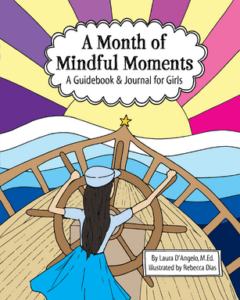Calm the CHAOS!
Everyday Mindfulness for Families with
A Month of Mindful Moments
Article by | Rebecca Dias, Illustrator of A Month of Mindful Moments, Author of Navasota Is Beautiful
Turning off screens, putting away technology, and getting outside can create meaningful memories and opportunities for connection
The start of the school year, and the start of the new year, are often seasons that we begin new activities and routines. As to-do lists pile up, we may find ourselves rushing from task-to-task, but losing sight of the “why” behind them. In our families, this can mean that time for meaningful connection gets lost amidst the busyness of work, school, technology, and stress.
In A Month of Mindful Moments: A Guidebook and Journal for Girls, author, educator, and guidance counselor Laura D’Angelo, M. Ed., shares how practicing mindfulness can help us slow down enough to live intentionally in our day-to-day activities. Mindfulness can also help us maintain a bigger-picture perspective of how our thoughts and actions impact ourselves and the world around us.
Here are some tips for living mindfully as a family, inspired by A Month of Mindful Moments: A Guidebook and Journal for Girls.

Keeping a journal
Reflective journaling, and encouraging conversations about those reflections, can help your family develop and model social and emotional maturity. It can also help children learn to express and work through challenges.
Maybe everyone in your family has their own journal, and daily or weekly, you take time for each member of the family to share something from their journal. Or maybe you can keep a family journal where family members take turns writing notes. You can also find guided journals that offer prompts or activities that family members can complete together or individually (such as A Month of Mindful Moments: A Guidebook and Journal for Girls or the Big Life Journal series).
A journal doesn’t have to involve writing – it can be an art journal, a doodle journal, a collage journal, a photo journal, a nature journal, etc. No matter what kind of journal you have, keeping a journal requires you to take time out of your schedule to notice your thoughts. Creating space to share about reflections as a family can open the door for conversation topics that might not come up otherwise.
Family acts of kindness
Sometimes we need to get outside of ourselves and think about others! A simple act of kindness can make our own problems seem smaller, and can help us recognize that we have a role in our communities, and the power to make a difference. Intentionally participating in family-based acts of kindness can shift the culture in your home from self-focused to others-focused.
Take turns choosing and participating in a family volunteer project. This can be as simple as picking up trash at a park, volunteering at a local food bank, or taking a care package to someone who is ill.
After-school “pause”
How often do you take time in your day to simply connect with your spouse or kids to listen and share about each other’s days, rather than discuss tasks that need to be done, or problems that need to be solved? Laura D’Angelo suggests taking a “Tea or Hot Chocolate Pause” for a few minutes each day (perhaps during snacktime after school) to ask intentional conversation questions. She also offers some suggestions for conversation starters.
An attempt to start this routine may be met with resistance at first – but persistence, and considering how to adapt this practice for your child’s unique needs and interests, can help build trust over time to make this “pause” in your day meaningful for you, your child, and family members. It also can help children (and adults!) cultivate reflective listening, empathy, and social skills.
Practicing gratefulness
How often do you talk about things you are grateful for? Is this something that could become a game on the way to school or on the way home, to see who can come up with the most things they are grateful for? Or a conversation topic at the dinner table (if you eat meals as a family)?
Laura suggests making a thankfulness jar that you and your family can add notes to about what you are thankful for. Review your answers together at the end of a week or month. You might be surprised by the joy that intentional gratitude brings to you and your home!
Time outdoors
Depending on your home environment, family schedules, and abilities, spending time in nature may require some planning. Regardless of how often you can do this, turning off screens, putting away technology, and getting outside can create meaningful memories and opportunities for connection. A small change of environment can also shift one’s attention and mood. Oxygen intake, and vitamin D, are immediate benefits to getting outside – plus a chance to exercise, admire the world around us, and recognize our place in it!
Changing family routines may take time, but living mindfully can help you and your family build connection as you make the most of life’s everyday moments.
Designed & illustrated by local Brazos Valley illustrator Rebecca Dias
A Month of Mindful Moments: A Guidebook & Journal for Girls is a 30-day mindfulness journal and activity book for girls ages 8-12 (parents & educators too!) filled with relevant, fun, research-based techniques that help girls grow in their appreciation of themselves and the world around them, while inspiring girls to navigate the storms of life with confidence and courage.
Shop local!
Muddy Waters Bookstore
120 E. Washington Ave., Navasota, TX 77868
936.900.4662
Also available at:
Amazon.com | Paperandseed.com
